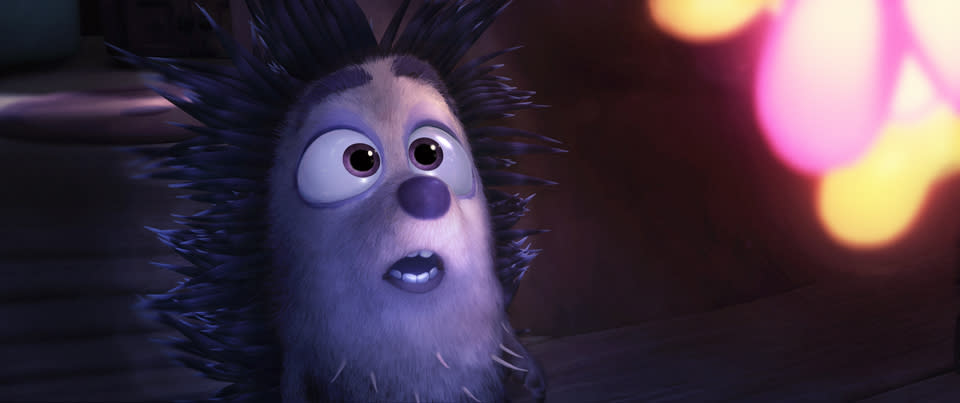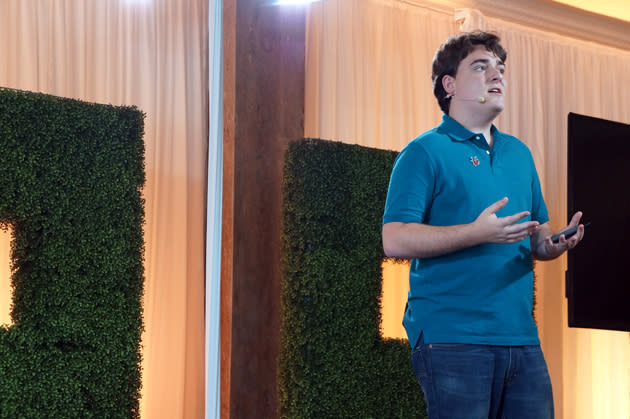'Henry' is Oculus' first, emotional step to making AI characters

If you've ever spent time in the company of young children watching colorful and cartoony TV shows geared to their innocence -- say something on Sprout or Nick Jr. -- then you'll know what it is to live in the world of Henry. The computer-animated virtual reality short about a lonely hedgehog is only the second to come from Oculus VR's newly founded Story Studio, an innovation lab of sorts for VR. But whereas most recent gaming- and entertainment-focused VR works have relied on cheap thrills, suspense and fear to dazzle viewers, Henry instead engages with empathy.
"That was the big question for me: How are people going to connect with him?" says director Ramiro Lopez Dau of Henry's emotional bent. "So we came up with this character who has an obvious problem: He wants to hug people and he's super spiky. So that was the connection because everyone deserves a friend. And Henry doesn't have a flaw. He's just like that; he's a hedgehog. ... So it's more about, okay, there's some meaning here. You will find someone who will accept you for who you are, which is a very universal message. ... There's going to be a very strong point to feel empathy for this guy."
But the Elijah Wood-narrated Henry wasn't always meant to go for the heart. The short, one of five slated for release before the launch of Oculus' Rift VR headset in the first quarter of 2016, was initially conceived as a comedy. Max Planck, Story Studio's technical director, credits lessons learned at the Disney-owned animation house Pixar, where he, Lopez Dau and Creative Director Saschka Unseld were previously employed, for helping pivot the story. "It's funny because, with Henry, we said it's gonna be a comedy. And we learned from Pixar that to make a laugh really land you have to ... really care about a character. And so I think Henry, for the most part, is more emotional on a sad spectrum. You feel for Henry. You want him to have a hug. It's funny how most people come out of it saying, 'I didn't laugh a lot, but I was crying.' And we're like: 'That's it!' We just wanted an emotional connection."
To achieve that emotional connection with the viewer, the team behind Henry latched onto a key interactive aspect: having Henry look directly at you during moments of extreme emotion with his big, inviting eyes. It's an idea that surfaced during a postmortem on Lost, the studio's inaugural short that debuted at this year's Sundance Film Festival. Save for some visual triggers, Lost, Planck explains, was mostly a passive experience, with the action unfolding around the viewer regardless of participation. But the team wondered what it could've been like had Lost's key characters looked into the eyes of the viewer.

Henry carrying his birthday cake
"There were moments in Lost where we thought it would be cool if the hand looked in our direction," says Planck. "Or, it'd be cool if the giant at the end ... if his eyes felt like they connected with me and not that there were these big eyes that were just sort of looking in a general direction. And so we started playing with, 'What if Henry looks at you?' And that's when we started [production]."
"[Henry] is a glimpse of what the future holds: Characters that can share their emotions and adventures with us in a very different way than film."
-- Saschka Unseld
Lopez Dau continues: "I think of all the moments we have that [Henry] looks at you. ... We came to the conclusion that the best moments that worked for that eye connection [were] when he was feeling something. When he's happy at the beginning or when he gets sad. That's when he's sharing with you that emotion."
The interactive hedgehog of today's Henry is actually a scaled-back version of a much more ambitious design: a real-time character imbued with artificial intelligence that fully reacts to you, the viewer. Unseld admits as much, saying that "[Henry] is a glimpse of what the future holds: ... characters that can share their emotions and adventures with us in a very different way than film." Planck elaborates on this and explains that, at one point during production, the team had "put in a little logic" that had Henry tracking viewers' eye movement. It was ultimately removed as the team felt it disrupted the flow of the narrative since the viewer isn't a part of the story and wouldn't impact its outcome.
"I think, eventually, we may want to go in that direction," says Planck. "But that's such a hard problem to have branching narrative or have artificial intelligence that can actually respond to you. We still wanted a director's touch. The director is deciding when events happen and how Henry should act."

Director Ramiro Lopez Dau
"We're finding that VR has to feel like there's a director who's orchestrating."
-- Max Planck
While future shorts from Story Studio will touch upon different themes and continue to push the technical boundaries of VR storytelling -- the upcoming, action-heavy Bullfighter will incorporate four instances of viewer teleportation or "teleports" -- Henry's breakthrough is in its emotional core and deliberate pacing. The short is, quite plainly, slow-moving. But it's that relaxed setting that lets viewers bond emotionally with Henry. So, too, does the decision to let viewers enter the world standing in Henry's apartment, within a tree, taking in the space, and then gently transition to sitting eye-level with him at his dinner table. In fact, I was instructed by the Oculus rep on-hand to sit on the circular, yellow rug beneath me to sidle up next to Henry.
It's all part of the rhythm VR storytelling requires, as the Story Studio team has discovered. Says Planck: "We've found something that Saschka's calling the 'in.' ... How do you get comfortable in VR? How do you realize, all right, I'm in this space and a director is now in control? ... We're finding that VR has to feel like there's a director who's orchestrating."
Though Henry is finally ready for the public's eyes, both Lopez Dau and Planck say it's possible the short could be remastered to add teleports, camera tweaks and (potentially) support for Oculus' new Touch controllers before it's made available free-of-charge on the Rift next year. Palmer Luckey, Oculus VR's founder, confirms this: "Lost and Henry and the other Oculus Story Studio films are going to be bundled with the Rift." As for Morpheus support, PlayStation's own VR platform, Luckey coyly admits that "it's too early to say." (Note, however, that is not a denial.)

Oculus VR co-founder Palmer Luckey
With an employee talent pool culled from Pixar and Industrial Light and Magic, and a focus on computer-animated, VR storytelling, Story Studio may seem like the next, big Hollywood animation house. But Luckey counters that presumption and, instead, holds up Henry as an educative guidepost for the industry; it's further proof of the legitimacy of VR. "Our goal isn't to make Story Studio into Warner Bros. We're trying to stay in line with our goal, which has always been to give creators the tools that they need to build for VR no matter who they are. ...That doesn't necessarily mean we'll never make money. It just means Story Studio is not the place we're trying to monetize."
"Our goal isn't to make Story Studio into Warner Bros."
-- Palmer Luckey
But, despite Luckey's protestations, the day where Story Studio turns a profit for parent company Oculus VR, however far out now, is firmly in Planck's sights.
"I do think that short films will need to have a revenue model," he says. "We're thinking there might be a future project that might be designed with monetization in mind. And the thing that's interesting to us -- although we haven't made a decision -- is episodic. With VR, everyone needs to warm into it. So, here's one short that is not too expensive. But if you love this, then you can buy the second episode. Much like how Telltale Games did with The Walking Dead. I think that's a great model and something that's inspiring for us, too."
Images: Oculus Story Studio (top image; Henry character art)

